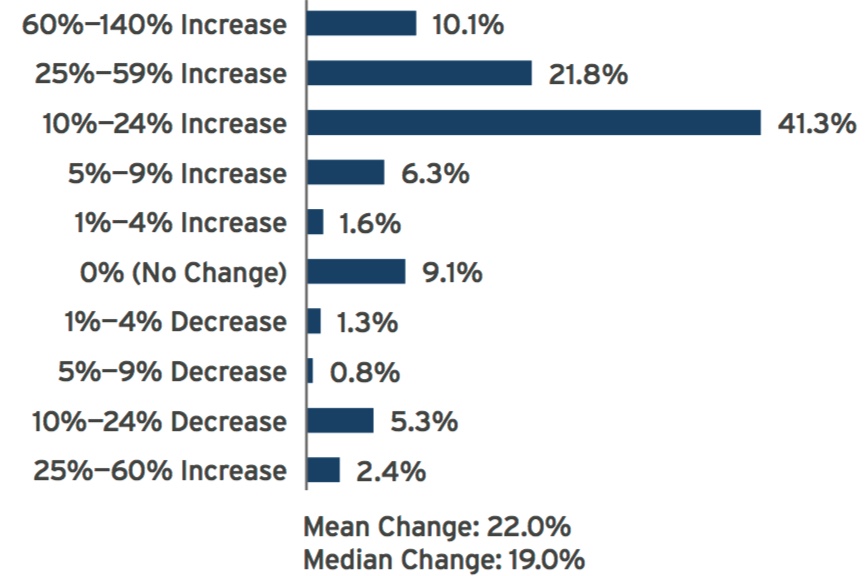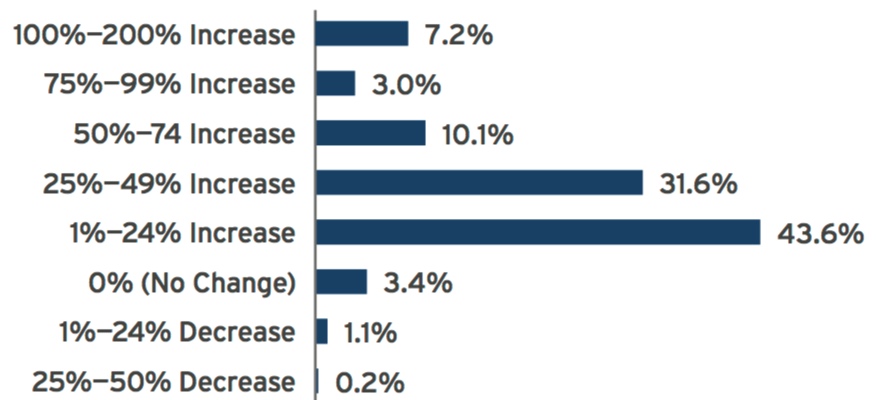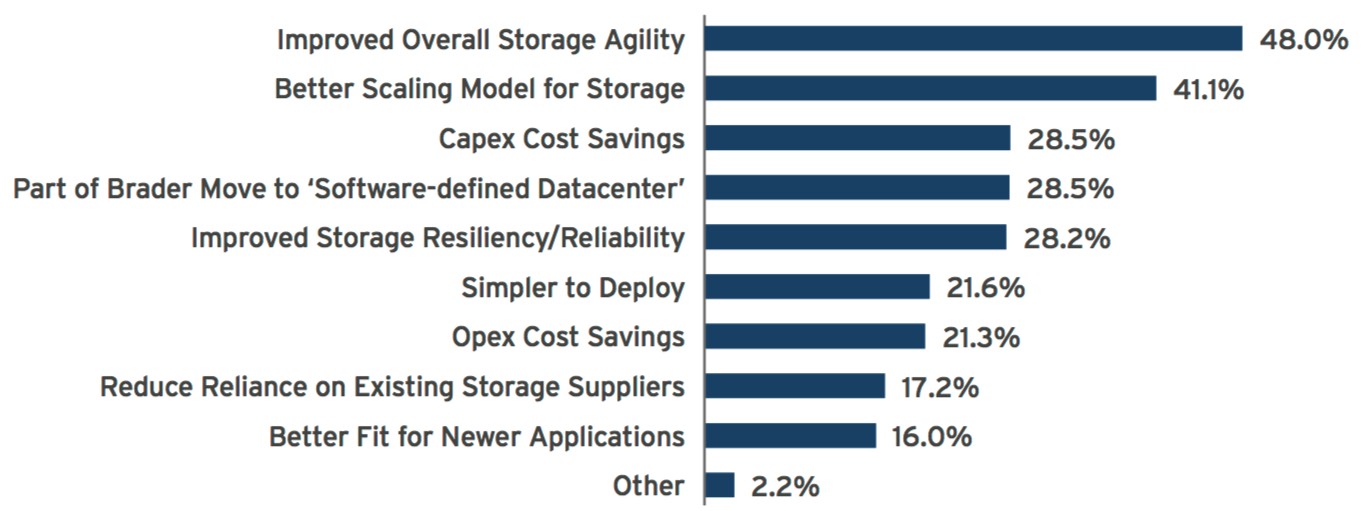Stay Ahead of Changing Storage Requirements With Software-Defined Storage
Report by 451 Research commissioned by FalconStor
This is a Press Release edited by StorageNewsletter.com on August 29, 2016 at 2:35 pmThis report was written in June 2016 by 451 Research, LLC and commissioned by FalconStor Software, Inc.
Stay Ahead of Changing Storage Requirements with Software-Defined Storage
Executive Summary
Although IT professionals are often hesitant to make major changes to their environment, storage must evolve to keep pace with other infrastructure elements such as compute and networking. The combination of relentless data growth, capital expenditures, complexity, fragmentation and huge operational overhead is prompting many enterprises to rethink their storage infrastructure strategies, especially in this era of unprecedented budgetary scrutiny. Now that enterprises want the IT stack to look and behave like a cloud, storage infrastructure must catch up. We believe that the industry is entering a transformative period, regarding both technology and how storage is organized and managed as IT in general evolves to the next-generation datacenter.
One such alternative is software-defined storage (SDS), which has the potential to help organizations modernize their infrastructures. Although the industry still has not settled on a standardized definition for SDS, the offerings in the market have focused primarily on the use of commodity hardware in place of rigid hardware appliances. Another potential benefit of SDS is a streamlined storage management process that often leverages catalogs to prepare and provision storage resources with reduced human intervention and an eye toward automation.
The storage industry is going through one of its most significant transformations with new technologies and storage media choices. As enterprise customers move toward hybrid cloud deployments, architectures will need to become more flexible and cost-efficient to match customer needs. Ultimately, storage architecture shifts toward SDS will be necessary to make on-premises infrastructure more agile and flexible to match the capabilities of cloud services.
Storage Challenges Will Drive Infrastructure Changes
Relentless data growth and modest storage budget increases have made storage environments at medium and large enterprises unsustainable. To meet the mounting challenge, storage professionals must be prepared to move beyond the traditional NAS and SAN storage appliances they have used for decades and leverage newer technologies such as object storage and SDS to handle their growing burdens.
Number of factors will accelerate pace of change in storage infrastructures:
Storage budgets are not increasing rapidly for more organizations (see Figure 1)
In our Q1 2016 Voice of the Enterprise Storage study, organizations expected to see a mean budget increase of 22% for storage spending over the next 12 months. Within the survey, 18.9% of respondents reported that they would have a decrease or no change in budget over the next 12 months. Although the majority of respondents reported an increase in budget, 41.3% expected a relatively small increase – 10-24%. With moderate budget increases expected in the foreseeable future, it is clear that storage professionals will need to get more capacity, performance and manageability for every dollar they spend on storage.
Data growth continues at an alarming page (see Figure 2)
For most organizations, data growth is a problem that becomes worse each year. In the Q4 2015 Voice of the Enterprise Storage survey, 51.9% of respondents reported that they expect to see a data growth rate of 25% or more in 2016. With compliance requirements rising in many industries, the data growth issue will only get worse because organizations will be required to retain data for longer periods. The rise of big data and analytics will also have an impact on storage retention because more organizations will be looking for ways to extract business value from data they would have previously discarded.
Management and orchestration across multiple storage platforms
is causing major headaches
Although the storage array market is a mature market, the majority of organizations are forced to use multiple platforms to satisfy their primary storage needs – beyond the backup and archive platforms present in many enterprise datacenters today. In our surveys, we found that 59% of respondents had two or more primary storage tiers in their environments (see Figure 3). Given the proprietary nature of the storage industry and the fact that most of the enterprise storage product lines have been built through acquisitions, even if an organization were to standardize on a single vendor for its storage, the multiple platforms it would need to deploy would create more complexity because each array platform would have management tools and proprietary data-protection capabilities, such as snapshot and replication, that can’t be leveraged across tiers.
Figure 1: Moderate Storage Budget Increases Are Expected for 2016
Q. By what percentage do you expect your organization’s overall storage spending plans to change in the next 12 months compared to the previous 12 months? n=623

(Source: 451 Research, Voice of the Enterprise: Storage, Q1 2016)
Figure 2: Data Growth Is Rampant
Q. By what percentage did your organization’s total deployed raw storage capacity (as measured in terabytes) change in the past 12 months? Please include capacity deployed both on-premises and in third-party clouds. (n=567)
(Source: 451 Research, Voice of the Enterprise: Storage, Q1 2016)
Figure 3: Most Organizations Deploy Multiple Primary Storage Tiers
Q. If you employ storage tiering in your environment, how many tiers do you currently operate? Please note that we do not consider backup/ disaster recovery to be a tier. (n=665)
(Source: 451 Research, Voice of the Enterprise: Storage, Q1 2016)
SDS Is Evolving to Meet Modern Requirements
In the last few years, SDS has emerged as an alternative to conventional integrated storage appliances. Although many vendors and early adopters have focused on the potential cost savings of SDS offerings, the flexibility and agility of these platforms will be the most important adoption drivers for this technology over the long haul. At this point, 17.6% of respondents claim they have already deployed SDS, while an additional 41% are considering implementing SDS (see Figure 4).
451 Research defines SDS as:
SDS provides a mechanism for provisioning and managing data storage independently of the underlying hardware. SDS approaches enable virtualized storage that can run on commodity hardware (e.g., x86 server) resources, which can be logically provisioned to applications and workloads on an automated, policy basis, sometimes via an API. SDS implementations vary widely, can support block, le and object-based approaches, and can operate stand-alone or as part of a hyperconverged approach.
SDS offerings in the market vary widely today, but there are a few essential elements and benefits that you should consider when evaluating this technology:
Broad support of commodity hardware
Hardware components such as processors, hard drives, flash SSDs, RAM and networking continue to improve rapidly and are made available to the commodity market before they make their way into enterprise storage arrays. As a result, organizations that utilize SDS storage software packages will be able to take advantage of the latest and greatest components when they become available and not have to wait for their array vendors to certify these components.
Pricing elasticity to transition spending toward OPEX
Organizations that wish to match the pay-as-you-go opex consumption model used by public cloud storage providers will need to find alternatives to traditional storage systems. In the SDS space, a number of players offer opex pricing models, which allow customers to pay licensing fees to their vendors based on the amount of resources they consume in a given time. In contrast, the capital expenditure (capex) model typically associated with storage systems requires large acquisition costs that are paid up front and depreciate over time. In the service provider world, organizations have used opex software pricing to reduce costs by eliminating instances when they are no longer needed, which allows the service providers to manage bursts of workloads without being stuck with a long-term capital expense.
API-based management to facilitate automation
Slow provisioning times continue to be an area of discontent for clients relying on traditional systems for storage resources. Through the use of API-based management, storage professionals – together with their infrastructure colleagues – can create service catalogs to allow clients to request resources and have them automatically provisioned through the APIs. APIs can also be used to facilitate rapid cloning of VMs for test/dev and other purposes. While the concept of using APIs for management and provisioning is new for enterprise storage environments, public cloud environments have been using APIs for these purposes for many years, which makes this a key requirement for organizations building a private cloud environment.
Storage virtualization for migration and optimization
Improved overall storage agility is the leading driver for SDS adoption, and this is a key issue that can be improved with storage virtualization (see Figure 5). While this capability has been widely used in array migration and retirement scenarios for years, the growing need for dynamic storage infrastructures will require technologies such as storage virtualization to opportunistically and non- disruptively move idle workloads o of expensive disk and ash arrays to allow performance-critical applications to use these resources. As mentioned previously, the majority of organizations today have multiple primary storage tiers that could potentially be optimized by a storage-virtualization engine. The performance advances that have been made with FC SAN, Ethernet and IB networking will help facilitate the rapid movement of data across storage silos.
Scale-out architecture to handle data growth
With the constant growth of storage, scale-out architectures are ideal because they allow storage professionals to add capacity to their infrastructure non-disruptively while minimizing the management impact of adding nodes. Another key benefit of scale-out is that it allows storage professionals to start out with a small configuration and gradually grow their storage infrastructure to match the needs of their workloads.
Figure 4: SDS Adoption Is Rising
Q. Does your organization have, or is it considering, a strategy of moving towards SDS approaches, where storage software and storage hardware can be purchased and installed separately, rather than as a single, integrated system? (n=564) 
(Source: 451 Research, Voice of the Enterprise: Storage, Q1 2016)
Figure 5: Drivers for SDS Adoption
Q. What are the main factors motivating your organization’s adoption of SDS approaches? (n=319)
(Source: 451 Research, Voice of the Enterprise: Storage, Q1 2016)
Recommendations
While the pressure to modernize your storage environment is clearly increasing, core storage functionality is still required to meet enterprise requirements. As you evaluate new products, keep in mind that SDS environments must continue to have the following enterprise storage traits:
- Resiliency. In the end, the most important attribute of any storage architecture is its ability to maintain and protect the integrity of the data that has been entrusted to its systems. Although no single form of data resiliency will be a perfect fit for every need, the architecture must contain capabilities such as RAID, mirroring and erasure coding to ensure data is not lost in the event of a hardware component or a controller failure.
- Performance. The storage world is in the midst of a major transformation from conventional hard drives to flash-based storage. The SDS architecture you choose should be optimized for leveraging ash and future solid-state technologies to keep up with the performance needs of workloads. Flash management is a key capability for storage systems going forward and should be a major consideration as you and your teams evaluate SDS offerings. Caching and tiering capabilities will be key here both for hybrid (disk/flash) arrays and for the next generations of all-flash arrays, which will leverage different classes of NAND flash, and the future solid-state media such as 3D Xpoint.
- Support for existing storage standards. Although there is a growing appetite for object storage, particularly with cloud and web-scale applications, current applications require standardized connectivity leveraging block-level protocols such as iSCSI or FC, or enterprise le services using the NFS or CIFS protocols. Persistent storage for containers is another key area that will likely be important in the near future.
- Data protection. The common data-protection techniques used in enterprise storage arrays will still be needed to protect workloads. Snapshots should be available to create recovery points to roll back errors or data-corruption events, and this technology is also commonly used to create clones of data sets for test/dev. Beyond the local replication used to protect data within a datacenter, remote replication must be available to make sure that data is still protected in the event of a large-scale disaster at the primary data site. To increase storage efficiency for primary and secondary storage, compression and deduplication technologies should be implemented when possible.
Organizational Considerations
- Collaborate with business stakeholders before building your new infrastructure. Your updated storage infrastructure must be able to satisfy a broad number of workloads while delivering the benefits of storage resource consolidation and automated provisioning through global catalogs. To do this, there must be collaboration between business stakeholders and domain experts to ensure that service classes can be defined according to workload needs. Without this step, you run the risk of building a menu from which no one wants to order.
- Automate to reduce management burdens. With relatively at budgets and rapidly growing data stores, the only way storage professionals will be able to say ahead is by automating as many processes as possible. A good place to start is with storage provisioning.













 Subscribe to our free daily newsletter
Subscribe to our free daily newsletter

